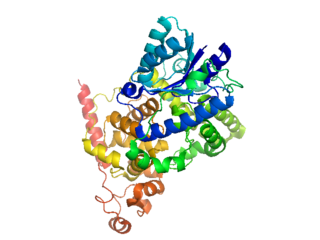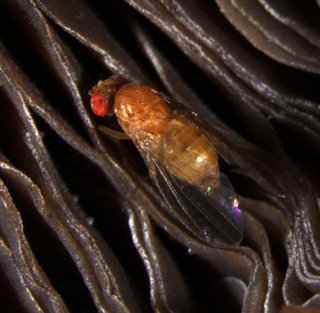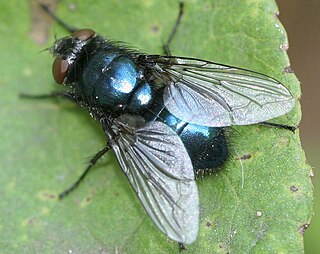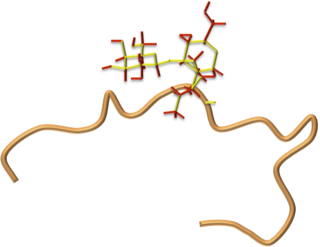
Drosophila is a genus of flies, belonging to the family Drosophilidae, whose members are often called "small fruit flies" or pomace flies, vinegar flies, or wine flies, a reference to the characteristic of many species to linger around overripe or rotting fruit. They should not be confused with the Tephritidae, a related family, which are also called fruit flies ; tephritids feed primarily on unripe or ripe fruit, with many species being regarded as destructive agricultural pests, especially the Mediterranean fruit fly.

Drosophila melanogaster is a species of fly in the family Drosophilidae. The species is often referred to as the fruit fly or lesser fruit fly, or less commonly the "vinegar fly", "pomace fly", or "banana fly". In the wild, D. melanogaster are attracted to rotting fruit and fermenting beverages, and are often found in orchards, kitchens and pubs.
A mitogen-activated protein kinase is a type of protein kinase that is specific to the amino acids serine and threonine. MAPKs are involved in directing cellular responses to a diverse array of stimuli, such as mitogens, osmotic stress, heat shock and proinflammatory cytokines. They regulate cell functions including proliferation, gene expression, differentiation, mitosis, cell survival, and apoptosis.

Cryptochromes are a class of flavoproteins found in plants and animals that are sensitive to blue light. They are involved in the circadian rhythms and the sensing of magnetic fields in a number of species. The name cryptochrome was proposed as a portmanteau combining the chromatic nature of the photoreceptor, and the cryptogamic organisms on which many blue-light studies were carried out.

Providencia is genus of Gram-negative, motile bacteria of the family Morganellaceae. It was named after Providence, Rhode Island, where C. A. Stuart and colleagues studied these bacteria at Brown University.
Transvection is an epigenetic phenomenon that results from an interaction between an allele on one chromosome and the corresponding allele on the homologous chromosome. Transvection can lead to either gene activation or repression. It can also occur between nonallelic regions of the genome as well as regions of the genome that are not transcribed.
Period (per) is a gene located on the X chromosome of Drosophila melanogaster. Oscillations in levels of both per transcript and its corresponding protein PER have a period of approximately 24 hours and together play a central role in the molecular mechanism of the Drosophila biological clock driving circadian rhythms in eclosion and locomotor activity. Mutations in the per gene can shorten (perS), lengthen (perL), and even abolish (per0) the period of the circadian rhythm.

Arthropod defensins are a family defensin proteins found in mollusks, insects, and arachnids. These cysteine-rich antibacterial peptides are primarily active against Gram-positive bacteria and fungi in vitro. However Drosophila fruit flies mutant for the fly defensin were more susceptible to infection by the Gram-negative bacteria Providencia burhodogranariea, and resisted infection against Gram-positive bacteria like wild-type flies. It remains to be seen how in vitro activity relates to in vivo function. Mutants for the defensin-like antimicrobial peptide Drosomycin were more susceptible to fungi, validating a role for defensin-like peptides in anti-fungal defence.

The bZIP intron RNA motif is an RNA structure guiding splicing of a non-canonical intron from bZIP-containing genes called HAC1 in yeast, XBP1 in Metazoa, Hxl1 or Cib1 in Basidiomycota and bZIP60 in plants. Splicing is performed independently of the spliceosome by Ire1, a kinase with endoribonuclease activity. Exons are joined by a tRNA ligase. Recognition of the intron splice sites is mediated by a base-paired secondary structure of the mRNA that forms at the exon/intron boundaries. Splicing of the bZIP intron is a key regulatory step in the unfolded protein response (UPR). The Ire-mediated unconventional splicing was first described for HAC1 in S. cerevisiae.

Cycle (cyc) is a gene in Drosophila melanogaster that encodes the CYCLE protein (CYC). The Cycle gene (cyc) is expressed in a variety of cell types in a circadian manner. It is involved in controlling both the sleep-wake cycle and circadian regulation of gene expression by promoting transcription in a negative feedback mechanism. The cyc gene is located on the left arm of chromosome 3 and codes for a transcription factor containing a basic helix-loop-helix (bHLH) domain and a PAS domain. The 2.17 kb cyc gene is divided into 5 coding exons totaling 1,625 base pairs which code for 413 aminos acid residues. Currently 19 alleles are known for cyc. Orthologs performing the same function in other species include ARNTL and ARNTL2.
The microbiota are the sum of all symbiotic microorganisms living on or in an organism. The fruit fly Drosophila melanogaster is a model organism and known as one of the most investigated organisms worldwide. The microbiota in flies is less complex than that found in humans. It still has an influence on the fitness of the fly, and it affects different life-history characteristics such as lifespan, resistance against pathogens (immunity) and metabolic processes (digestion). Considering the comprehensive toolkit available for research in Drosophila, analysis of its microbiome could enhance our understanding of similar processes in other types of host-microbiota interactions, including those involving humans. Microbiota plays key roles in the intestinal immune and metabolic responses via their fermentation product, acetate.

Drosomycin is an antifungal peptide from Drosophila melanogaster and was the first antifungal peptide isolated from insects. Drosomycin is induced by infection by the Toll signalling pathway, while expression in surface epithelia like the respiratory tract is instead controlled by the immune deficiency pathway (Imd). This means that drosomycin, alongside other antimicrobial peptides (AMPs) such as cecropins, diptericin, drosocin, metchnikowin and attacin, serves as a first line defence upon septic injury. However drosomycin is also expressed constitutively to a lesser extent in different tissues and throughout development.

Drosophila neotestacea is a member of the testacea species group of Drosophila. Testacea species are specialist fruit flies that breed on the fruiting bodies of mushrooms. These flies will choose to breed on psychoactive mushrooms such as the Fly Agaric Amanita muscaria. Drosophila neotestacea can be found in temperate regions of North America, ranging from the north eastern United States to western Canada.

Diptericin is a 9 kDa antimicrobial peptide (AMP) of flies first isolated from the blowfly Phormia terranova. It is primarily active against Gram-negative bacteria, disrupting bacterial membrane integrity. The structure of this protein includes a proline-rich domain with similarities to the AMPs drosocin, pyrrhocoricin, and abaecin, and a glycine-rich domain with similarity to attacin. Diptericin is an iconic readout of immune system activity in flies, used ubiquitously in studies of Drosophila immunity. Diptericin is named after the insect order Diptera.

Drosocin is a 19-residue long antimicrobial peptide (AMP) of flies first isolated in the fruit fly Drosophila melanogaster, and later shown to be conserved throughout the genus Drosophila. Drosocin is regulated by the NF-κB Imd signalling pathway in the fly.

Metchnikowin is a 26-residue antimicrobial peptide of the fruit fly Drosophila melanogaster that displays both antibacterial and antifungal properties. This peptide is expressed strongly in the Drosophila fat body, but is also expressed at surface epithelia in the trachea and gut. This is regulated by the NF-κB signalling pathways Toll and Imd. Metchnikowin is named after Russian immunologist Élie Metchnikoff, one of the founders of modern immunology.

The Drosophila quinaria species group is a speciose lineage of mushroom-feeding flies studied for their specialist ecology, their parasites, population genetics, and the evolution of immune systems. Quinaria species are part of the Drosophila subgenus.

The Imd pathway is a broadly-conserved NF-κB immune signalling pathway of insects and some arthropods that regulates a potent antibacterial defence response. The pathway is named after the discovery of a mutation causing severe immune deficiency. The Imd pathway was first discovered in 1995 using Drosophila fruit flies by Bruno Lemaitre and colleagues, who also later discovered that the Drosophila Toll gene regulated defence against Gram-positive bacteria and fungi. Together the Toll and Imd pathways have formed a paradigm of insect immune signalling; as of September 2, 2019, these two landmark discovery papers have been cited collectively over 5000 times since publication on Google Scholar.
Baramicin (Bara) is an antimicrobial peptide gene of the fruit fly Drosophila melanogaster. Baramicin is a prominent element of the fly immune response: of the most abundant immune peptides detected in the fly hemolymph, the BaraA gene is responsible for 9 of the 24 peptides first described for their high concentrations after systemic infection.

The Bomanin gene family encodes a group of immune peptides that are essential for Drosophila fruit fly defence against infection by many pathogens.













